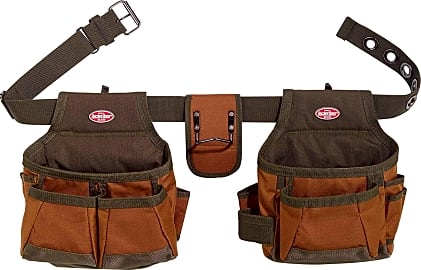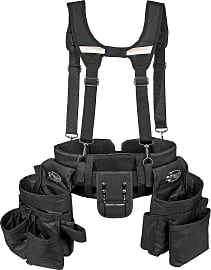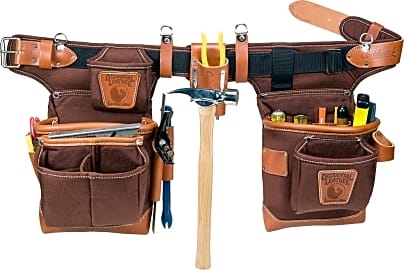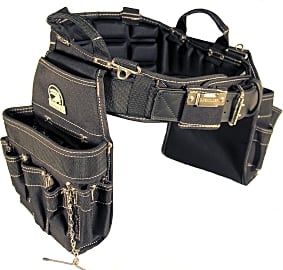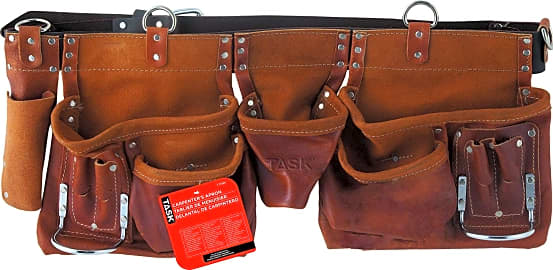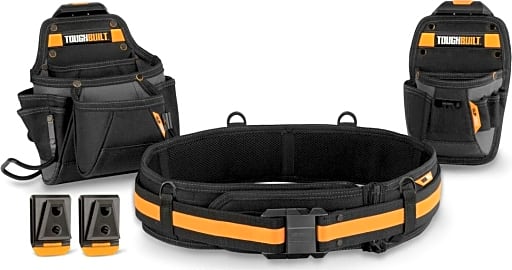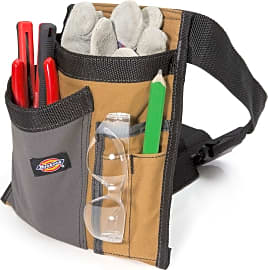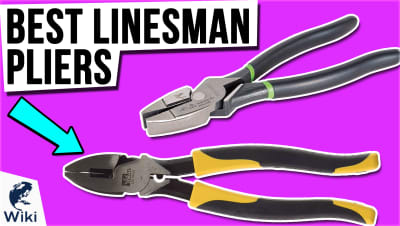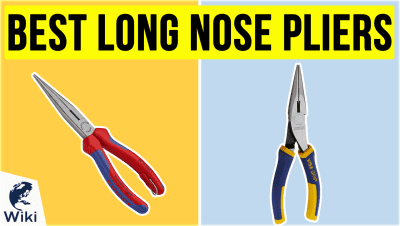The 10 Best Tool Belts

This wiki has been updated 40 times since it was first published in June of 2015. Calling all DIYers, carpenters, electricians, and construction professionals. You'll never be left scrambling for the right equipment again with one of these high quality tool belts. They'll help you keep everything you need within easy reach, no matter how big or small the job. We've included something for all budgets, as well as options made from various types of hard-wearing materials. When users buy our independently chosen editorial choices, we may earn commissions to help fund the Wiki.
Editor's Notes
February 16, 2021:
While all of our previous picks for this category were still available and argubally decent picks for this list, we took issue with the obvious absence of a couple selections.
The first and most obvious issue we had was that our list included no suspender-equipped framing rigs for carpenters, although some options have attachment clips — like our new addition the TradeGear SZB and old choice the Gatorback B240. To rectify this deficiency, we included the Dead On DO-FR Framers Rig, which is equipped with suspenders and 32 pockets.
Our second issue, which I admit may have been amplified slightly by my personal bias, was that we didn’t have any electrician-specific designs on our list. To fix this up, we added the TradeGear SZB. The main tool pocket on this one is full of sleeves, which help prevent your linesman, side-cutting and needle-nose pliers from getting too tangled up throughout the day, and it comes in two sizes, so it can accommodate 26- to 55-inch waists. As was previously mentioned, this belt is compatible with suspenders, and you can even order a pair along with it for a pretty reasonable price.
Our last new addition this time around was the Veto Pro Pac TA-WB. Despite being a fairly simple model, we decided to rank this option right at the top of our list, as we thought that it was a good, basic pick that’s likely to be well suited to many DIYers and general handymen that need a simple apron they can load up for whatever sort of miscellaneous work the day’s about to throw at them. The company backs its reputation with a five-year warranty on this choice.
The models we removed this time around were the Original Pink Box PB2BELT, Custom LeatherCraft 3-Pocket and Fasite Hanging Pouch. There’s nothing intrinsically wrong with these models, some might even find them ideal for crafting or work around the yard, but given the current competition in this space, it seemed like their sustained presence on this list would be questionable, and we feel that our users will be much better served by our new picks.
There’s no doubt that a good tool belt is an essential part of just about any tool collection, but very rarely does it amount to an all-in-one answer to your organizational problems. For further storage solutions for tools, check out our lists of rolling tool cabinets, tool bags and tool backpacks.
June 13, 2019:
It's nearly impossible to select only one tool belt that's the best option for all uses, but for many, we think the Occidental Leather Adjust-to-Fit, the Bucket Boss Builder's Rig, or the Gatorback B240 are all fine options. They're made with strong, sturdy materials, so you can go about your work without worry. That said, some users wish that the hook-and-loop fastening on the Gatorback was stronger, which is only a small drawback when you consider its robust overall construction. We still like the MagnoGrip, as well, but its interesting design can be slightly problematic, as the magnets often pick up metal pieces when you don't mean to do so. We've also kept the ToughBuilt Handyman, because its modular construction ensures that it is useful for various projects. But it, too, has a small drawback, although only for some users. It features an extension that makes it larger for bigger waists, but this extension is attached by way of a zipper that sometimes has a mind of its own. This model's concept and usability are sound on the whole, though. Finally, at this time, we're still against including the somewhat popular DeWalt 20-Pocket Pro Framer; the suspenders have a few plastic parts that simply can't hold up to the kind of abuse they're likely to receive, which can cause issues in the long run.
Special Honors
Iron Dog Modular Set If you just can't seem to find what you need in a pre-assembled model, consider the Iron Dog Tool Gear System. You start with the belt, then select pouches, holders, and pockets to your specifications, so you don't have to make do with less than perfection. As a bonus, you can change the configuration with each new job, if you'd like. irondogtoolgear.com
Diamondback Denali The Diamondback Denali bills itself as the "ultimate framer's outfit," and we're inclined to agree with that assessment. Featuring six loops, eight pockets, and 16 slots, it has the beefy capacity to match its admirable strength. Be prepared to pay for the privilege. toolbelts.com
Bucket Boss If one of this company's suspender setups doesn't suit you – and they do have every look from high-vis to camoflage – then you can always take the modular approach, pick a bare belt, and then decide which pouches you need to make it perfect. There selection is wide enough that it's unlikely you'll be unable to put together something that suits you. bucketboss.com
Why Quality Matters: Tool Belt Edition
The most important thing to know when selecting a tool belt is what type of instruments you need it to hold.
The most important thing to know when selecting a tool belt is what type of instruments you need it to hold. There is a question of durability, to be sure, especially given the fact that different professions require different tools, some of which may be sharp, heavy, or hazardous, but the first order of business is to make a list of all your essentials tools, so you can find a belt that will comfortably accommodate them all.
After that, take a look at the materials out of which a given belt is made. This is especially important if you plan on using smaller pockets to store tacks, screws, or nails. Leather is a reliable option, as it protects the skin from any sharp points or edges that might protrude from within the belt. Polyester and nylon are also excellent options for their durability if you are in any way averse to leather. Either way, if the material and its stitching aren't reinforced, metal points can easily cause those pockets to tear, and might even puncture your skin.
If you've got a bad back (or a narrow waist), you may want to consider a tool belt with suspenders, which will help to hold the belt in place while taking its weight off of your lower back. If you have a wider waist, you'll want to make sure you find a belt that's capable of fastening in your size. And, regardless of your size or pain issues, if you've got delicate skin that is given to bruising, you'll want a belt that includes some type of padding in its design.
All Within Arms Reach
Tool belts aren't all that complicated. They're designed to equip you with any the tools you may need to get a job done without running back and forth to your toolbox, saving you time and, potentially, eliminating the need for a second pair of hands.
The overlying pockets on most belts are designed by using polyester or nylon, while the underlying belt is made of reinforced leather (usually gray, brown, or black). These pockets store anything from a screwdriver or a tape measure, to a set of drill bits or pliers. Most belts also feature what are known as D-clips, or rivets, for looping in a hammer, a cat's paw, a speed square, or a level. A belt's smaller pouches are reserved for storing tiny accessories, like a box of screws or nails.
Certain belts come equipped with suspenders or padding, both of which are meant to minimize the burden that a person's midsection has to bear. Heavy weight or high friction in the area of the lower back might result in anything from blisters to muscle pain and even spinal alignment issues after chronic use.
A Brief History of The Tool Belt in America
Belts, as a concept, have been in existence since the Bronze Age. And while it is difficult to pinpoint when the term "tool belt" came into being, it's not a stretch to assume that people have been attaching tools to their waists since the dawn of the Roman Empire. (We know, after all, that Roman soldiers wore swords on their belts, at least.)
But as American hardware grew into a major industry, self-styled handymen took pride in assembling a small arsenal of tools that they could use around the house.
In America, throughout the Gilded Age and the Industrial Revolution, most craftsmen and laborers carried their tools inside of a satchel. Considering the daunting images of brave men scaffolding early New York skyscrapers without so much as a rope to save them if they were to fall, it's pretty surprising that these workers wouldn't want to minimize their movement at such heights. Tool belts would have at least made it a little easier on them.
But as American hardware grew into a major industry, self-styled handymen took pride in assembling a small arsenal of tools that they could use around the house. The tool belt, which arose in part as an implement aimed at such DIY-ers, achieved its peak during the 1980s, thrust forward thanks to a variety of television shows hosted by experts including Bob Vila and a 1990s favorite, Tim "the Toolman" Taylor.
Since the turn of the 21st century, a lot of companies have turned their focus toward electronic appliances and digital power tools. These are progressive additions to the everyday workbench, but they in no way replace the tools a handyman still needs to keep around his belt.



